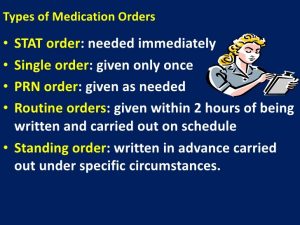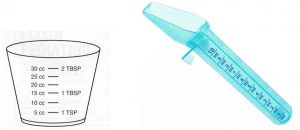3. Medication orders. Metric system. Measuring devices. Conversion table. The QMAP’s role in starting, changing or stopping medication orders. Translating physician’s orders. Common medical abbreviations translated into everyday terms.
-
3.1. Common Abbreviations
- Abbreviation – a shortened form of a word or phrases;
- Often used in medical and residents’ records, such as physician’s orders;
- Learn abbreviations for terms common to medication administration;
- On the Medication Administration Record (MAR), abbreviations should be spelled out;
- Be aware that abbreviations can lead to mistakes if they are not legible;
- Always check with the supervisor if you have questions about abbreviations.
DOSES ROUTES OF ADMINISTRATION gm = gram po = by mouth
mg = milligram pr = per rectum
mcg = microgram OD = right eye
cc = cubic centimeter OS = left eye
ml = milliliter OU = both eyes
tsp = teaspoonful AD = right ear
tbsp = tablespoonful AS = left ear
gtt(s) = drop(s) AU = both ears
oz = ounce SL = sublingual(under the tongue)
mEq = milliequivalent SQ = subcutaneous (under the skin)
kg = kilogram per GT = through gastrostomy tube
Buccal=between cheek & gum
TIMES OTHER QD = every day record MAR = medication administration
BID = twice a day OTC = over the counter
TID = three times a day DC = discontinue
Q = every tab=tablet
QID = four times a day cap=capsule
q_h = every __ hours EC=enteric coated
qhs = at bedtime oint/ung=ointment
ac = before meals supp=suppository
pc = after meals sol=solution
PRN = as needed XL/XR=extended release
QOD = every other day
ac/hs = before meals and at bedtime
pc/hs = after meals and at bedtime
STAT = immediately
C= with, s=without, x=times. R=right, L=left.
-
3.2. Definition of an Order
X – The written or oral directions that a physician or other prescribing practitioner provide about a resident’s medication or medications


-
3.3. Components of a Complete Order
Components of a Complete Order.
- Client name (Last and first).
- Medication name
- Strength of medication (if required)
- Dosage of medication to be administered
- Route of administration
- Specific directions for use, including frequency of administration
- Reason for administration if the medication is ordered PRN or as needed
- Provider signature.
Orders for medications prescribed for PRN administration must include
- Symptoms that require the administration of the medication;
- Exact dosage;
- Exact time frame between dosages;
- Maximum dosage to be administered in 24-hour period;
QMAPs may be responsible for receiving and transcribing orders.
- It is important that QMAP understands required procedures as well as the limitations of QMAP role in medication documentation.
- An order is required to administer, change or discontinue any medication or treatment;
- It is important to know the components of a medication order;
- Contact the prescribing health care provider if the order is not legible – DON’T GUESS!
- If an order is not complete or clear on how to administer; the QMAP must contact supervisor or physician – DON’T GUESS!
- Example – Ativan 0.5 mg. by mouth every 4 hours PRN for pacing or agitation;
- Physician must be contacted if more than four doses are needed in 24-hour period.
A “dose” has 3 parts.
- Size: The dose/size is the amount of drug taken at any one time. This can be expressed as the weight of drug (e.g. 250 mg), volume of drug solution (e.g. 10 mL, 2 drops), the number of dosage forms (e.g. 1 capsule, 1 suppository) or some other quantity (e.g. 2 puffs).
- Frequency: The dosage regimen is the frequency at which the drug doses are given.
- Examples include: 2.5 mL twice a day, one tablet three times a day, one injection every four weeks.
- Duration: the time during which the dose continues working.
What is strength of preparation: The strength is the amount of drug in the dosage form or a unit of the dosage form (e.g. 500 mg capsule, 250 mg/5 mL suspension).
Example: A patient is prescribed 30 mg amitriptyline (dose). Amitriptyline is available in 10-mg tablets. (Strength of preparation)
Calculation:
Number of tablets required=30/10×1=3
A child is prescribed 240 mg paracetamol (dose). Paracetamol suspension is available as a solution of 120 mg/5 ml.(strength of preparation)
Calculation:
Volume of paracetamol required=240/120 ×5=10 ml
-
3.4. Metric system
Metric system – a decimal system of standard weights and measures using the:
- milligram (mg);
- gram (g or gm);
- kilogram (kg);
- milliliter (ml);
- liter (l)… among others.
Note: a cubic centimeter (cc) is the same amount as a milliliter (ml) –or– 1 cc = 1 ml
Household system – a system based on common, though not standard, measuring devices:
- teaspoon and tablespoon can be different sizes.
Equivalents that must be learned:
- 1 tsp. = 5 cc = 5 ML
- 3 tsp. = 1 Tbsp = 15 cc = 15 ML = 1/2 OUNCE
- 2 Tbsp = 30 cc = 30 ML = 1 oz

Measuring devices.

Medication cap. Spoon

Oral syringe Oral dropper.
-
3.5. The QMAP’s role in starting, changing or stopping medication orders
In order to start, change or stop a medication order, you must:
- Have a written physician’s order. Verbal and phone orders cannot be accepted by a QMAP;
- Facilities may accept faxed orders from a physician, but may not accept faxes from a pharmacist unless it is a copy of a signed physician order;
- If a client returns from an inpatient hospital stay, the facility must obtain new orders from an authorized practitioner, for each routine and PRN medication that was not included on the discharge orders. “Resume previous orders” is not acceptable;
- Properly document the new information on the MAR;
- Follow your facility’s policies and procedures;
-
3.6. Test 3 (What did you learn?)
Identify the information missing for each medication order below:
1) Risperdal 2 mg. Give 1 tablet by mouth
2) Riopan Liquid 15 ml. by mouth every hour as needed
3) Aricept 1 tablet by mouth at bedtime
4) Tylenol 2 tablets by mouth every 4 hours as needed for shoulder pain
5) Ativan 0.5 mg. 1 tablet by mouth as needed